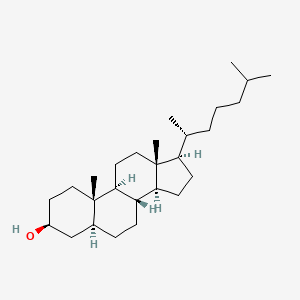| MeSH term | MeSH ID | Detail |
|---|---|---|
| Diabetes Mellitus | D003920 | 90 associated lipids |
| Diabetes Mellitus, Type 2 | D003924 | 87 associated lipids |
| Cataract | D002386 | 34 associated lipids |
| Hypercholesterolemia | D006937 | 91 associated lipids |
| Alcoholism | D000437 | 27 associated lipids |
| Brain Diseases, Metabolic | D001928 | 9 associated lipids |
| Biliary Fistula | D001658 | 13 associated lipids |
| Xanthomatosis | D014973 | 17 associated lipids |
| Xanthomatosis, Cerebrotendinous | D019294 | 14 associated lipids |
Dihydrocholesterol
Dihydrocholesterol is a lipid of Sterol Lipids (ST) class. Dihydrocholesterol is associated with abnormalities such as Exanthema, Morphologically altered structure, protrusion, Dehydration and Xanthoma. The involved functions are known as Regulation, Biochemical Pathway, Methylation, Metabolic Inhibition and Biosynthetic Pathways. Dihydrocholesterol often locates in envelope, Mitochondria, Lipid Bilayers, Host Cell and Membrane. The associated genes with Dihydrocholesterol are GRAP2 gene, PTP4A2 gene, HSD3B7 gene, MBD2 gene and IGF2BP3 gene. The related lipids are Sterols, Cardiolipins, Pregnanes, 7-hydroxy-4-cholesten-3-one and Hydroxycholesterols. The related experimental models are Mouse Model.
Cross Reference
Introduction
To understand associated biological information of Dihydrocholesterol, we collected biological information of abnormalities, associated pathways, cellular/molecular locations, biological functions, related genes/proteins, lipids and common seen animal/experimental models with organized paragraphs from literatures.
What diseases are associated with Dihydrocholesterol?
Dihydrocholesterol is suspected in Xanthoma, Xanthomatosis, Cerebrotendinous, Coronary heart disease, Exanthema, Morphologically altered structure, Dehydration and other diseases in descending order of the highest number of associated sentences.
Related references are mostly published in these journals:
| Disease | Cross reference | Weighted score | Related literature |
|---|
Possible diseases from mapped MeSH terms on references
We collected disease MeSH terms mapped to the references associated with Dihydrocholesterol
PubChem Associated disorders and diseases
What pathways are associated with Dihydrocholesterol
There are no associated biomedical information in the current reference collection.
PubChem Biomolecular Interactions and Pathways
Link to PubChem Biomolecular Interactions and PathwaysWhat cellular locations are associated with Dihydrocholesterol?
Visualization in cellular structure
Associated locations are in red color. Not associated locations are in black.
Related references are published most in these journals:
| Location | Cross reference | Weighted score | Related literatures |
|---|
What functions are associated with Dihydrocholesterol?
Related references are published most in these journals:
| Function | Cross reference | Weighted score | Related literatures |
|---|
What lipids are associated with Dihydrocholesterol?
Related references are published most in these journals:
| Lipid concept | Cross reference | Weighted score | Related literatures |
|---|
What genes are associated with Dihydrocholesterol?
Related references are published most in these journals:
| Gene | Cross reference | Weighted score | Related literatures |
|---|
What common seen animal models are associated with Dihydrocholesterol?
Mouse Model
Mouse Model are used in the study 'On the mechanism of accumulation of cholestanol in the brain of mice with a disruption of sterol 27-hydroxylase.' (BÃ¥vner A et al., 2010).
Related references are published most in these journals:
| Model | Cross reference | Weighted score | Related literatures |
|---|
NCBI Entrez Crosslinks
All references with Dihydrocholesterol
Download all related citations| Authors | Title | Published | Journal | PubMed Link |
|---|---|---|---|---|
| Aoki K et al. | Anagliptin decreases serum lathosterol level in patients with type 2 diabetes: a pilot study. | 2015 | Expert Opin Pharmacother | pmid:26098722 |
| Moraes EA et al. | Cholestanol-loaded-cyclodextrin improves the quality of stallion spermatozoa after cryopreservation. | 2015 | Anim. Reprod. Sci. | pmid:26005214 |
| Luister A et al. | Increased plant sterol deposition in vascular tissue characterizes patients with severe aortic stenosis and concomitant coronary artery disease. | 2015 | Steroids | pmid:25814070 |
| Benesch MG et al. | A DSC and FTIR spectroscopic study of the effects of the epimeric coprostan-3-ols and coprostan-3-one on the thermotropic phase behaviour and organization of dipalmitoylphosphatidylcholine bilayer membranes: Comparison with their 5-cholesten analogues. | 2015 | Chem. Phys. Lipids | pmid:25804450 |
| Matsuoka K et al. | Competitive Solubilization of Cholesterol/Cholesteryl Oleate and Seven Species of Sterol/Stanol in Model Intestinal Solution System. | 2015 | J Oleo Sci | pmid:26136176 |
| Silbernagel G et al. | Intestinal cholesterol absorption, treatment with atorvastatin, and cardiovascular risk in hemodialysis patients. | 2015 | J. Am. Coll. Cardiol. | pmid:26022817 |
| Lin X et al. | Plasma biomarker of dietary phytosterol intake. | 2015 | PLoS ONE | pmid:25668184 |
| Sistiaga A et al. | The Neanderthal meal: a new perspective using faecal biomarkers. | 2014 | PLoS ONE | pmid:24963925 |
| Hallikainen M et al. | Cholesterol metabolism and serum non-cholesterol sterols: summary of 13 plant stanol ester interventions. | 2014 | Lipids Health Dis | pmid:24766766 |
| Imperatore C et al. | Phallusiasterols A and B: two new sulfated sterols from the Mediterranean tunicate Phallusia fumigata and their effects as modulators of the PXR receptor. | 2014 | Mar Drugs | pmid:24705503 |
